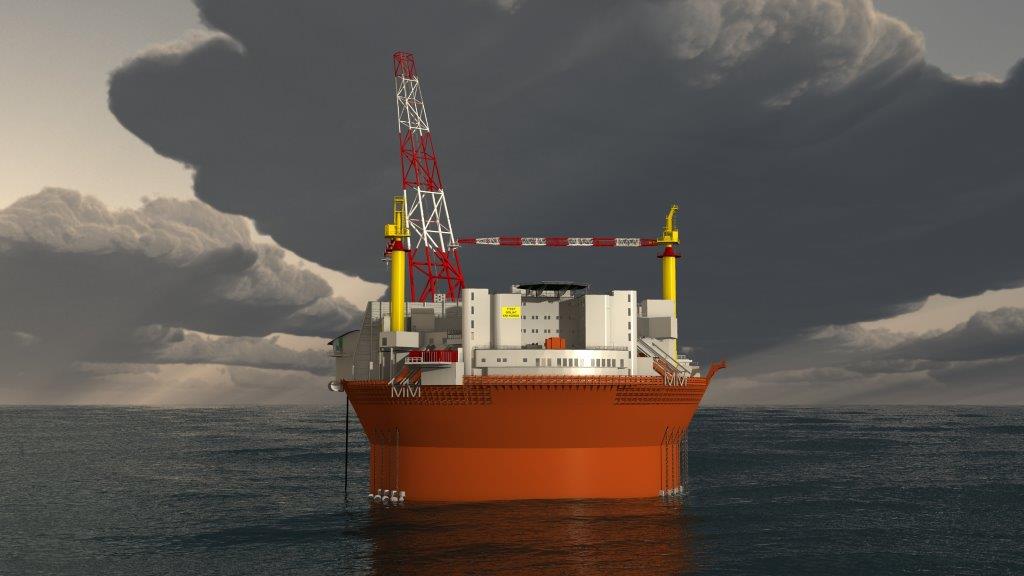April 2014, Vol. 241 No. 4
Features
Sevan 1000 FPSO Readied For Barents Sea

Eni Norge has selected the Sevan 1000 FPSO, developed by Sevan Marine, to produce the Goliat field in the Barents Sea northwest of Hammerfest at a depth of 400 meters. Italian energy company Eni Norge is operator of the field with an ownership of 65% while Statoil owns 35%.
The Goliat field was discovered in 2000 and will be the first oil field to come on stream in the Norwegian sector of the Barents Sea. It contains approximately 174 MMbbls of oil and 8 Bcm of gas.
The FPSO for Goliat is being built by Hyundai Heavy Industries in Ulsan, South Korea. Later this summer it will be transported to the field offshore Hammerfest. Once completed, it will have an oil production capacity of 100,000 bpd, gas production of 3.9 MMSm3/d and an oil storage capacity of 1 million bbls.
Off-the-shelf systems are the exception in this project. Most of the components for the FPSO are tailor-made and specially adapted to enable safe and reliable oil production under harsh weather conditions.
Circular in design, the Goliat FPSO is constructed such that rain, snow and ice will drain and slide down walls and roofs which enable the platform to withstand all anticipated ice loading. However, heating cables will be installed in the floors in especially exposed areas such as evacuation routes and the helicopter deck.
“This is to prevent the build-up of too much snow and ice,” explained Ole Rekdal, Eni Norge’s Head of Safety and Emergency Preparedness. “All equipment in the auxiliary equipment room is built-in, and we have installed extra lighting to compensate for the long periods of winter darkness.”
However, it has been a challenge during construction to ensure a good working environment while maintaining adequate ventilation of the process plant.
“Ventilation is vital in order to minimize the risk of explosions,” said Rekdal. “The safest approach would be to design a plant entirely open to the elements, but this would be intolerable for the personnel who have to work there,” he added. “We have come up with a solution by which the outer walls of the process plant are made of partly overlapping vertical steel plates. This provides effective ventilation while protecting personnel from the weather.”
Safer Buoy Mooring
A new concept for off-loading from the Goliat FPSO and loading onto shuttle tankers has been developed, making it possible to carry out operations around the entire circumference of the platform.
Electrical Power From Shore
The energy supply concept for the Goliat platform is based on partial electrification. This means that instead of generating all the energy out on the platform, about half of the electrical consumption will be supplied from shore.
The submarine cable from the mainland to the Goliat platform will be the longest of its kind. ABB is manufacturing the cable which will be installed in 2014.
The submarine cable to be laid out to Goliat will have a maximum supply capacity of 75 MW and at the platform the normal consumption from the cable will be between 20-40 MW. A gas turbine generator on the platform will generate an additional 20-30 MW and an associated amount of heat. This configuration will ensure the supply of energy to the platform and promote a high level of energy efficiency.
To transmit enough electrical energy out to the platform, it will be necessary to upgrade the electrical supply grid in the Hammerfest area.
The upgrading consists of two projects:
1. Siemens is the principal contractor for the onshore work. This upgrade will consist of the construction of a new supply line with increased capacity in an existing section of the regional grid, a new substation near Hyggevatn and new underground cables.
In addition, overhead lines which become superfluous as a result of the upgrade will be demolished and cleared. Eni Norge will be responsible for carrying out this upgrade and the new systems belonging to the regional and local supply grid will be handed back to Hammerfest Energi Nett when the installation is completed.
Skanska, Bravida, Elnett Energi AS and Istad Energimontasje will act as subcontractors for Siemens. Skanska has chosen Larsen Maskin & Transport as its subcontractor.
2. Hammerfest Energi Nett will be responsible for upgrading the local electricity supply grid.
The new substation at Hyggevann will supply large parts of the Hammerfest area with electricity in addition to serving the Goliat platform.
In connection with the construction of the substation, Eni Norge will carry out simplification and reinforcement of the electrical supply grid system, among other things by removing some existing overhead lines. The costs will be borne entirely by Eni Norge (65 %) and Statoil (35%).
To ensure enough electricity for everyone, Eni and Statnett will install a rapidly responding compensation system which will stabilize grid voltage and increase the transmission capacity of the grid between Skaidi and Kvaløya.
Production is planned to commence in the final quarter of 2014 when the Goliat Field will enter the operational phase.





Comments